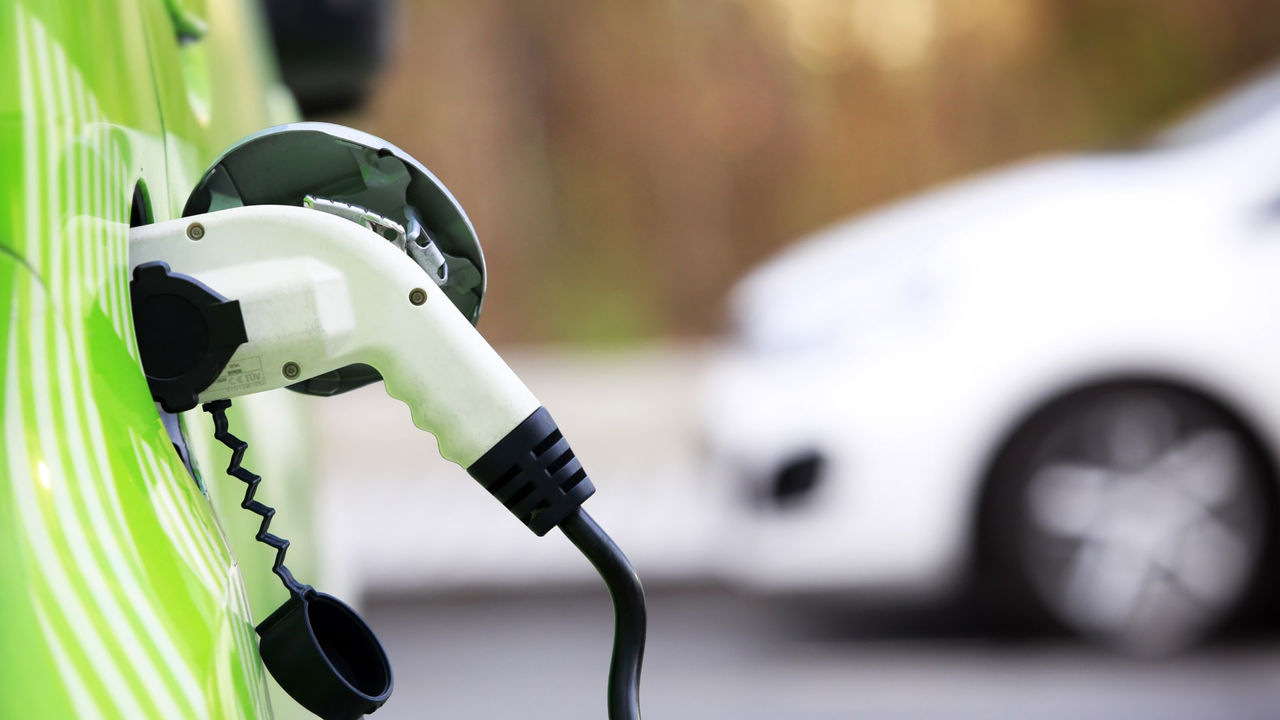- About residential EV rates
- Home Charging EV2-A rates
- Electric Vehicle Rate Plan EV-B rates
- Off-peak charging
We offer three rate plans that EV customers are eligible for
Home Charging EV2-A
EV2-A combines:
- Your vehicle's electricity costs
- Your home’s electricity usage
Electric Vehicle Rate Plan EV-B
EV-B:
- Separates your vehicle's electricity costs from those of your home
- Involves the installation of a second meter
Electric Home Rate Plan (E-ELEC)
E-ELEC:
- Ideal if you electrify your home with one or more of the following: Electric vehicle (EV), battery storage, electric heat pump for water heating or climate control (space heating or cooling).
- Includes a $15-per-month Base Services Charge and lower kWh prices compared to some other rate plans.
- Your home does not need to be all-electric to qualify for this rate plan.
EV rates are Time-of-Use (TOU) rates
TOU rates:
- Are priced based on the time of day the electricity is used
- Encourage customers to avoid using electricity during the early evening when the cost of electricity is highest
- Do not limit how much electricity you can at any time
Changing your rate schedule:
- You are allowed to change your rate schedule twice in the first 12 months.
- After the second rate change you must remain on the new rate for 12 months.
Installing a second meter
- Do you want to install a second meter dedicated to your electric vehicle (EV)? You are only eligible for EV-B on that meter.
- Your house will be eligible for other PG&E rate plans (except for the Home Charging EV2-A rate).
Programs available to EV rate customers
- EV2-A customers can enroll in SmartRate™.
- EV-B customers cannot enroll in the following programs: SmartRate™, Medical Baseline, CARE and FERA.
What time of day does your household use the most energy?
- Can you shift your energy use to a time when costs and demand are lower—such as early morning and afternoon?
Can you shift your household’s energy usage to off-peak hours? EV rates:
- Lower your monthly bill
- Support a healthier environment
- Do you charge primarily at home?
- Are you able to charge your vehicle between 12 a.m. – 3 p.m.?
- Can your current EV charger fill your battery overnight?
- Can your charger provide enough charge to support your daily commute?
If you answered yes to most of these questions, an EV rate could be right for you.
- Energy is typically cheapest between 12 a.m. and 3 p.m.
- EV rate customers save money on their monthly bill by charging during these off-peak hours.
- See if an EV rate plan can save you money with the PG&E’s EV Savings Calculator’s rate tool.
- Determine which non-EV rate is best for you. Perform a rate comparison by logging in to your PG&E account.
If you don't have an online account, register now.
What is the EV2-A rate?
Combines home and vehicle energy use
- Our Home Charging EV2-A rate applies to both your home energy and your vehicle's electricity use.
- It offers lower prices during the hours when producing energy is cheapest.
Best for off-peak charging
This rate plan works for those who have one or more of the following and can charge during off-peak hours:
- An electric vehicle (EV)
- Battery storage
- An electric heat pump
Set charging times for lowest price periods
- Most EVs and home charging stations allow you to program when you want to charge them.
- Set the charging time to be during the lowest TOU price periods.
EV2-A is a TOU rate
- A TOU rate has different prices for electricity depending on the time of day.
- Costs on the EV2-A rate are lowest from 12 midnight to 3 p.m., every day. This includes weekends and holidays when demand is lowest.
- This is the best time to charge your vehicle and to use larger household appliances, such as:
- AC
- washer
- dryer
- dishwasher
Peak and off-peak hours apply
Remember:
- Off-peak hours are 12 midnight to 3 p.m.
- Peak hours (4-9 p.m.): electricity is more expensive
- Partial-peak (3-4 p.m. and 9 p.m. - 12 midnight)
The cost to charge your EV during off-peak hours is about the same as paying $3.30 per gallon at the pump. Learn more about eGallon.
Eligible for SmartRate™
EV2-A customers are eligible to participate in SmartRate™.
EV2-A rates schedule
- Review the EV2-A full schedule and rates.
- This rate schedule applies everywhere PG&E provides electric service.
EV2-A Summer (June – September)
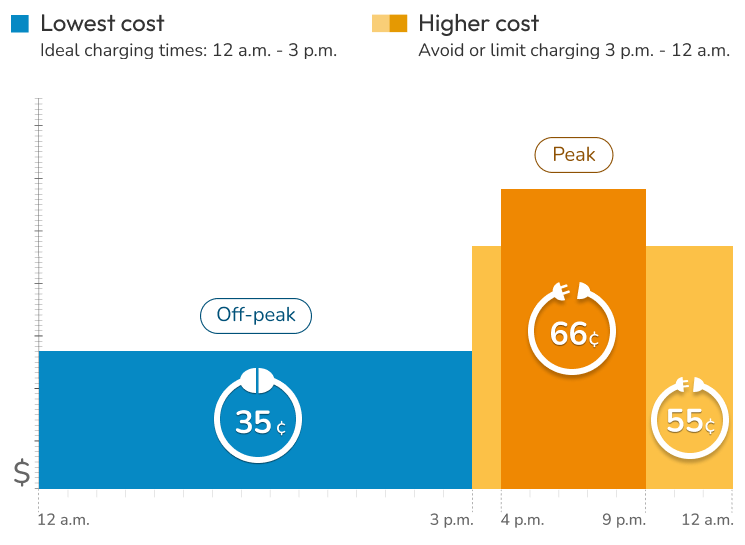
EV2-A Winter (October – May)
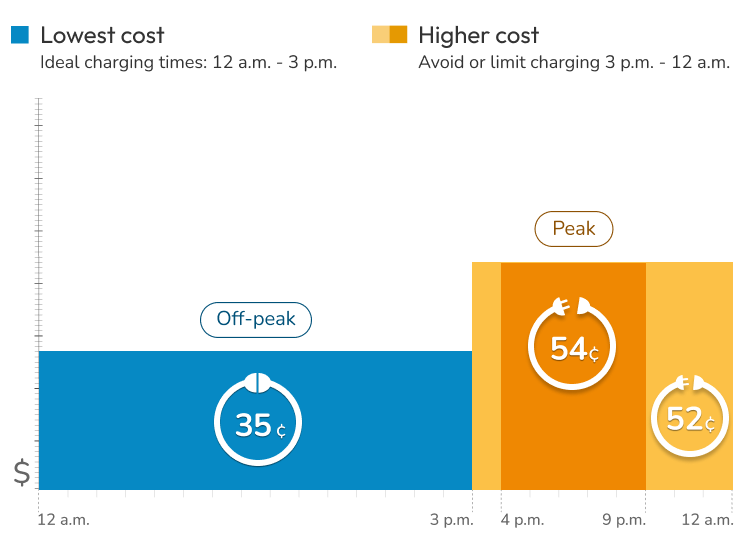
Note:
- Daily peak period is (4-9 p.m.), partial peak is (3-4 p.m. and 9 p.m. - 12 midnight) and off-peak period is (all other hours).
- Costs shown above are per kWh.
- Customers with high energy usage (over 800% baseline allowance) over the last 12 months are not eligible for this rate.
What is the EV-B rate?
Separates home and vehicle energy costs
- EV-B rate separates your vehicle’s electricity costs from those of your home.
- It requires the installation of a second meter.
- The price for charging varies based on the time of day.
- Your home energy use is measured separately through its own rate.
No shifts to home energy use
The EV-B rate is best for those who:
- Want to track their EV charging separately from their home energy usage, and/or
- Are not able to shift their home electric use to off-peak hours
No set charging times
- Charge any time
- Maximize your savings by reducing usage from:
- 7 a.m. to 11 p.m. on weekdays
- 3-7 p.m. on weekends and holidays
EV-B is a TOU rate
This means there are different prices for electricity depending on the time of day.
- Costs on EV-B are lowest from 11 p.m. to 7 a.m. when energy demand is lowest. This is the best time to charge your vehicle.
- Electricity is more expensive during:
- Peak periods (2-9 p.m.)
- Partial-peak periods (7 a.m. - 2 p.m. and 9-11 p.m.)
Learn about the eGallon
- The cost to charge your EV during off-peak hours is the about the same as paying $3.35 per gallon. Learn more about eGallon.
Second meters are required
Do you want to install a second meter dedicated to your electric vehicle (EV)?
- You are only eligible for EV-B on that meter.
- Your house will be eligible for other PG&E rate plans (except for the Home Charging EV2-A rate).
Not eligible for CARE, FERA or Medical Baseline
- The EV-B rate is not eligible for the CARE, FERA or Medical Baseline discounts.
- For customers enrolled in CARE, the EV2-A rate may be an option..
Not eligible for SmartRate™
- EV-B customers are not eligible to participate in SmartRate.
- The EV2-A rate may be an option for you.
EV-B rates schedule
- Review the EV-B full schedule and rates.
- This rate schedule applies everywhere PG&E provides electric service.
EV-B Summer (May – October)
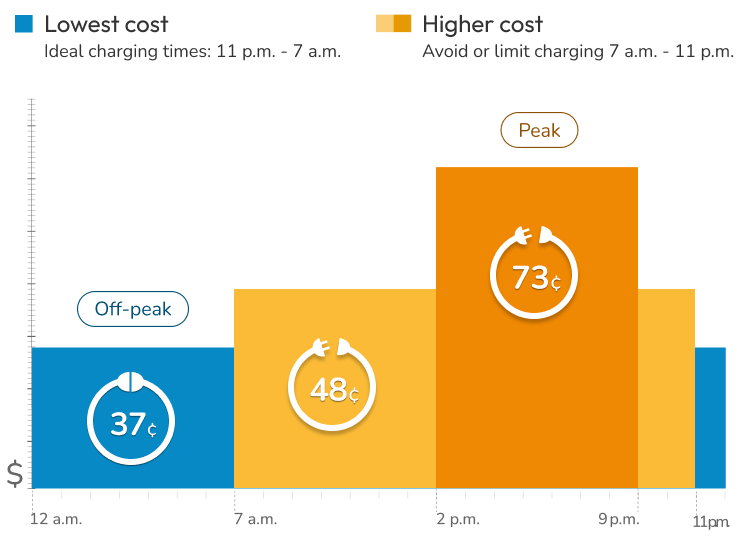
EV-B Winter (November – April)
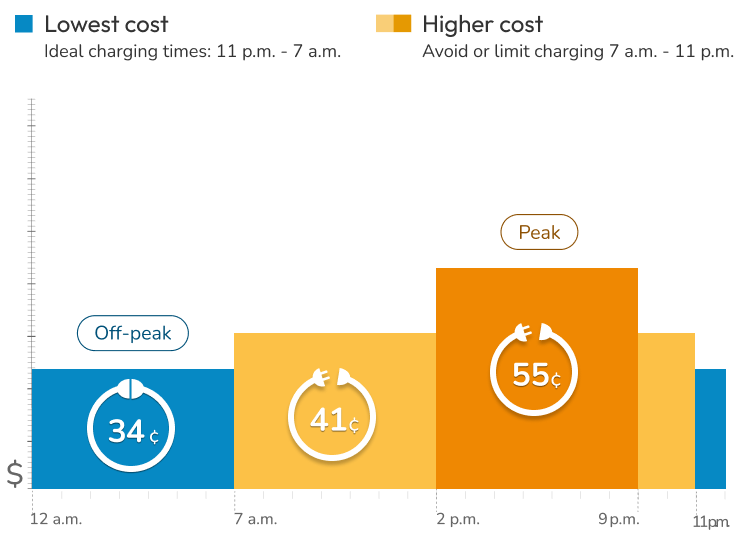
Note:
- Weekends and holidays only include the peak period of (3-7 p.m.) and the off-peak (all other hours) period.
- Costs shown above are per kWh.
- Customers with high energy usage (over 800% baseline allowance) over the last 12 months are not eligible for this rate.
Learn more about Baseline Allowance.
What does off-peak mean?
Less strain on the energy grid
- Using energy during low production times helps spread electric usage to times of the day when there is less strain on the grid.
- These hours are referred to as ‘off-peak.’
- They vary depending on which TOU rate a customer is enrolled in.
Lower rates for home charging
- Charging at home allows EV owners to take advantage of these lower rates.
- By shifting energy usage to off-peak hours, you could also reduce your utility bill.
How to charge your EV during off-peak hours
- You will need to set up a charging schedule on your charging station directly.
- You can also do this through the charging network app or through the vehicle itself.
There are different ways you can learn how to do this:
- Check the manual of your charging station or vehicle.
- Go online and search:
- "Set charging schedule for (your EVSE brand name)"
- "Set charging schedule of (EV make/model)"
- About business EV rates
- How business EV works
- Benefits
- Rate plan comparison
- Steps to enroll
PG&E offers two EV rates for business customers with on-site EV charging
The rate plans help you meet your EV charging needs, while keeping fuel costs lower than gasoline or diesel alternatives. Both plans combine a customizable monthly subscription charge with a time-of-use rate to help you save money.
These rate plans are specifically designed for customers with separately metered EV charging at locations such as workplaces, multi-unit dwellings, and retail as well as sites with fleets and public fast charging stations.
Business Low Use EV Rate - BEV1
Best suited for:
- EV charging installations up to and including 100 kilowatts (kW)
- Smaller workplaces and multi-unit dwellings
Business High Use EV Rate - BEV2
Best suited for:
- EV charging installations of 100 kilowatts (kW) and above
- Sites with fleets and public fast-charging stations
Frequently asked questions about business EV rates
It depends on what other PG&E programs you are enrolled in.
The following programs are ineligible under the BEV1 and BEV2 rate plans.
- Option R – Not eligible
- Option S – Not Eligible
- SmartMeter™ Opt Out
- Commercial CARE
- Demand Response programs – Peak Day Pricing (PDP), Excess Supply Demand Response Pilot (XSP), Supply Side II Demand Response Pilot (SSP II), Scheduled Load Reduction Program, and Permanent Load Shift Program
- NEM 1
- Complex NEM options (Except NEM2-PS and NEM2-MT)
- 100% Standby
- Mixed Use Standby
Note: If you enroll in this rate, you will either be unenrolled from the programs listed above or not receive the financial benefits.
To enroll:
- You must be a commercial business with EV charging infrastructure.
- You must be interval billed on a MV90 meter or SmartMeter™.
- You must have a separate meter for your EV chargers.
- The meter can only be connected to EV charging infrastructure.
- It cannot be shared with other end uses such as a building or irrigation.
- Customers with approved EV submeters and an approved MDMA can use their submeter to enroll in the Business EV rates. For additional information on EV Submetering, visit the EV Submetering page.
Note: There is an exception where customers may include appliances and apparatus that solely serve the overall EV infrastructure on the EV-only meter.
Visit the Business EV Tariff for more details on incidental and integral load.
No.
- These Business EV rates are optional.
- Businesses with EV charging infrastructure can be on an otherwise applicable business rate schedule.
To enroll in the Business EV rate or change your subscription level on an existing meter:
- Sign in to manage your account or
- Call PG&E's Business and Solar Customer Service Center at 1-877-743-4112, Monday - Friday, 8 a.m. ‑ 5 p.m.
There are two primary costs:
- Your subscribed kW level
- A volumetric kWh charge, the price of which is determined by your time-of-use period
The time-of-use schedule is designed to reduce usage on the electric grid when demand is highest (4-9 p.m.) while also providing consistently low rates for:
- A large portion of the nighttime (9 p.m. - 9 a.m.)
- Part of the afternoon (2 - 4 p.m.)
- An even more affordable super off-peak period (9 a.m. - 2 p.m.)
These time-of-use periods match PG&E's rate time periods, which:
- More accurately reflect the cost of the energy
- Support California's renewable initiatives to promote energy usage when solar energy is most plentiful
This is when usage of the electric grid is the highest.
The kW subscription replaces a demand charge. It’s similar to how you pay for your mobile phone or cable service.
- Choose a subscription plan to match your estimated kW usage
- Get billed that amount every month
Subscription levels differ by the rate plans:
- Customers who choose the BEV1 rate can subscribe in blocks of 10 kW up to 100 kW per month.
- Customers who choose the BEV2 rate can subscribe in blocks of 50 kW, starting at 100 kW per month with no cap.
Most customers receive (secondary) power via lower voltage distribution lines. Some customers receive (primary) power via higher voltage transmission lines.
Subscription charges are 100% allocated to distribution charges.
See table below.
Customer with monthly demand of exactly 100 kW may choose either BEV1 or BEV2 rate.
Customers on BEV rate are encouraged to actively manage their subscription levels to avoid paying overage fees. When you enroll on BEV rate, you will be defaulted to calendar billing, which allows for simpler subscription management process for both the customer and PG&E. You can change your subscription at any time during the billing cycle except if you incur an overage fee on the third billing cycle of your grace period.
In that case, PG&E will auto-adjust your subscription to the appropriate level to cover your actual demand and you will need stay on this auto-adjusted subscription level for the next three billing cycles.
When you first enroll on BEV rate, you have a three-month grace period for the first three billing cycles during which you won't incur any overage fees for exceeding your subscription amount.
Outside of the grace period, any kW overage will be charged:
- In increments of 1 kW
- At twice the rate of the subscription kW costs.
For example, if the subscription fee was $12.41 per 10 kW block (i.e., $1.24 per 1 kW), the overage fee would be $2.48 per kW.
If a customer used exactly half of the subscription block over the subscription level in the given cycle, the cost of the overage fees is the same as selecting the next subscription level. For example, an overage fee of $2.48 for 5 kW is $12.41, which is the same as the cost of the of 10 kW subscription block.
Yes, these rates are available to CCA, DA and PG&E bundled customers.
Enroll by calling PG&E's Business and Solar Customer Service Center at 1-877-743-4112, Monday - Friday, 8 a.m. - 5 p.m.
You're not limited on vehicle types. You can charge golf carts, forklifts, ATVs, passenger cars, even planes and electric bikes.
You must have a commercial electric vehicle charging station (or stations) in order to be eligible for these rates.
- Solar: Yes.
- Stationary Battery: Yes. Stationary battery must be:
- Connected to a meter that is separately metered for EV charging
- Used solely for EV changing
- Generator: Yes. A renewable energy generator could be used in conjunction with Business EV rates if it follows NEM rules.
There is no explicit restriction against traditional generators being attached to the charging area. The meter itself must be only used for EV charging.
Yes. Customers with approved EV submeters and an approved MDMA can use their submeter to enroll in the Business EV rates. For additional information on EV Submetering, visit the EV Submetering page.
Customers can request a second meter by calling a Building Services expert at 1-877-743-7782 Monday – Friday, 7 a.m. - 6 p.m.
Yes. Any connected stationary battery which is solely used for EV charging qualifies for these Business EV rates.
BEV rates schedule
- Review the BEV full schedule and rates.
- This rate schedule applies everywhere PG&E provides electric service.
Time-of-use or Hourly Flex Pricing

Features of EV rates for business customers
Monthly subscription charge¹
Choose your subscription level based on your maximum monthly EV charging kW consumption. This can be adjusted throughout the month as often as needed – until the last day of each billing cycle – to avoid overage fees.
Overage fees
At the end of your billing cycle, if your actual consumption (kW) exceeds your subscription level, you will be charged an overage fee of two times the cost of one kW for each kW over your subscription level.
For example, using a subscription fee of $12.41 per 10 kW block (i.e., $1.24 per 1 kW), your overage fee would be two times this at $2.48 per 1 kW. If you have a 60 kW subscription level, but use 61 kW in a given billing cycle, you will pay for the 60kW subscription ($74.46) plus the additional 1 kW at double the price ($2.48). The cost of the overage fees is the same as selecting the next subscription level for exactly half of the subscription block in the given cycle. For example, an overage fee of $2.48 for 5 kW is $12.41, which is the same as the cost of the of 10 kW subscription block.
Grace period
To help you determine the best subscription level, you have a grace period with no overage fees for three billing cycles when you first enroll or add more EV charging installations. If you incur overage fees on your third and final grace period billing cycle, your subscription level will be automatically adjusted to cover your overage amount. You will also need to stay on this auto-adjusted subscription level for your next three billing cycles, after which you may modify your subscription level without limitation.
Time-of-use rate
In addition to your monthly subscription charge, you are charged a volumetric rate (kWh) based on how much energy you use and when you use it. Charging is the most affordable midday when PG&E has higher levels of renewable energy generation. Time-of-use periods are consistent year-round with no seasonality.
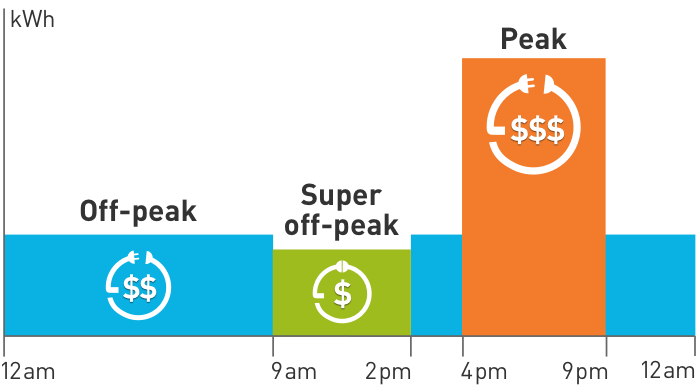
Please refer to the Business EV Tariff (PDF) for exact values.
Business EV rate calculator
Calculate your monthly fueling costs with the dynamic Business EV rate calculator tool. Estimate monthly fueling costs, toggle between rate option, see how your costs change depending on subscription level, set your charging schedule, compare BEV to other applicable rates, and more.
1Calculated based on Carbon Intensity (CI) as identified by the California Air and Resources Board in the Low Carbon Fuel Standard (LCFS) regulation. Based on PG&E's 2018 power mix (PDF).
2California Air and Resources Board (CARB), July 2018
*The electric grid connects customers to power by way of transmission and distribution lines. Most customers receive (Secondary) power via lower voltage distribution lines. Some customers receive (Primary) power via higher voltage transmission lines.
Enroll in EV rates for business
Step 1: Estimate your connected load
Estimate your connected load by totaling the kW capacity of all EV charging equipment that will be on the meter. Look at the name plate rating on the equipment for kW capacity.
Step 2: Choose your rate plan
- Business Low Use EV Rate - BEV1
- Business High Use EV Rate - BEV2
Step 3: Choose your subscription level
Choose a subscription level based on your estimated connected load. You get a grace period of three consecutive billing cycles when you first enroll in any BEV rate option, during which:
- You won't be charged any overage fees.
- You'll be notified by email and text message (opt-in required) if your demand exceeds your chosen subscription level.
- Your subscription level will be automatically adjusted to match your actual demand if an overage occurs in the third billing cycle of your grace period. However, it will not adjust down if your demand is less than your chosen subscription level. In the event of an auto-adjustment, you will need to stay on the auto-adjusted subscription level for the next three billing cycles.
Step 4: Enroll in the BEV rate
- Once you're ready, sign in to manage your account or call our Business and Solar Customer Service Center at 1-877-743-4112, Monday - Friday, 8 a.m. - 5 p.m.
After you enroll, adjust your subscription level as needed and start saving money. You can adjust your subscription level throughout your billing cycle as often as you want – until the last day of each billing cycle – to avoid overage fees (if applicable).
Ready to enroll?
Sign in to manage your account or call our Business and Solar Customer Service Center at 1-877-743-4112, Monday - Friday, 8 a.m. - 5 p.m.
Tools for choosing rate plans
Online rate analysis
- See what rate plans PG&E offers.
- Learn how the different rate plans work.
- Get a personalized rate analysis.
- Find your best rate plan.
Low-cost and no-cost energy-saving tips
Find ways to save with very little out-of-pocket expense.
Energy-related glossary
Better understand your energy statement. Learn common energy-related terms.

